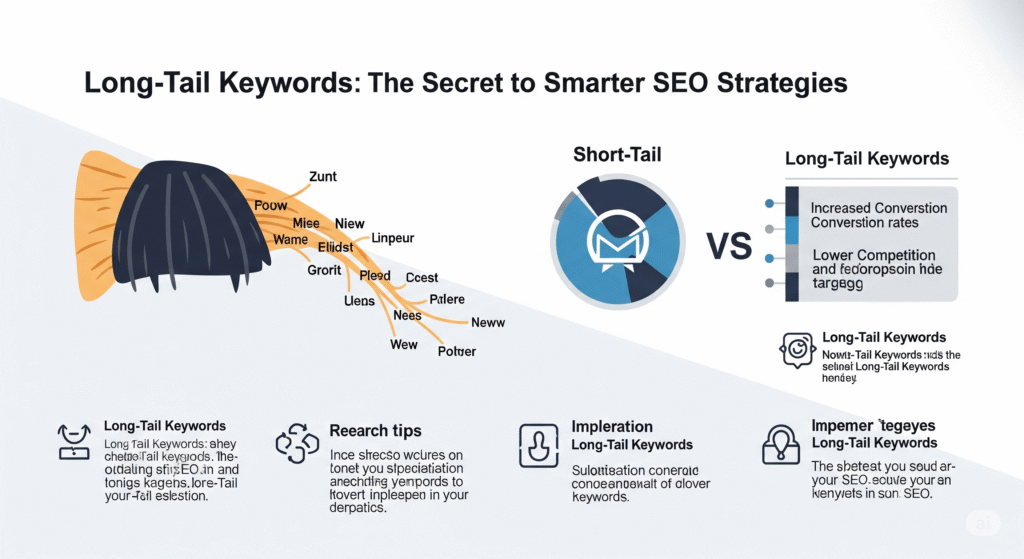In today’s competitive digital environment, ranking high on search engines requires more than just targeting high-volume keywords. Instead, smart marketers are turning to a more effective and focused approach: long-tail keywords. These specific search phrases can bring in more qualified traffic, improve conversion rates, and make your SEO strategy far more efficient.
In this blog, we’ll explore what long-tail keywords are, why they matter, and how to effectively use them to optimize your SEO efforts.
1. Introduction
SEO is the core of natural web presence. Basically, SEO is based significantly on knowledge and application of keywords that individuals search using search engines.
But it has become very hard to target broad or generic keywords because of heavy competition. Long-tail keywords provide an alternative better option—helping you to reach a more specific audience with less competition.
This post will demonstrate how long-tail keywords can be used to strengthen your SEO campaign and enable you to reach searchers who are willing to interact or convert.
2. What Are Long-Tail Keywords?
Long-tail keywords are search phrases that typically contain three or more words. They are more specific than broad keywords and often indicate a clearer intent from the user.

Examples:
- Short-tail keyword:
laptops - Long-tail keyword:
best laptops for graphic design under $1000
Short-Tail vs. Long-Tail Comparison:
| Feature | Short-Tail Keywords | Long-Tail Keywords |
|---|---|---|
| Length | 1–2 words | 3+ words |
| Search Volume | High | Lower individually, but adds up |
| Competition | Very high | Low to medium |
| Conversion Potential | Low | High (more specific intent) |
Why They’re Called “Long-Tail”:
The term comes from the “search demand curve,” where a few popular keywords form the “head,” and the bulk of search terms—specific, low-volume queries—make up the “long tail.”
3. Why Long-Tail Keywords Matter for SEO Optimization
Lower Competition:
Long-tail keywords are less competitive, making it easier for smaller websites to rank on the first page of search engines.
Higher Conversion Rates:
Users searching long-tail phrases usually know what they want. This leads to higher engagement and conversion rates.
More Targeted Traffic:
These keywords attract users specifically interested in your niche, product, or service.
Ideal for Voice and Mobile Search:
As voice search grows, people are speaking in full sentences. Long-tail keywords reflect these natural, conversational queries.
4. How to Find Long-Tail Keywords
There are several effective ways to discover long-tail keywords relevant to your business:
Keyword Research Tools:
Use platforms like Google Keyword Planner, Uber suggest, Ahrefs, and SEMrush to identify keyword variations and search volumes.
Google Autocomplete and Related Searches:
Begin typing your keyword into Google and see what suggestions appear. Also, scroll to the bottom of the search results to view related searches.
Analyze Competitor Content:
Use SEO tools to see what long-tail keywords your competitors rank for and identify opportunities they might be missing.
Explore Forums and Q&A Sites:
Websites like Reddit, Quora, and niche-specific forums reveal the real questions people are asking—perfect for identifying content ideas and keywords.
5. How to Use Long-Tail Keywords in Your SEO Strategy
Once you’ve identified relevant long-tail keywords, integrate them strategically across your content:
- Page Titles: Include the keyword naturally in your title.
- Meta Descriptions: Summarize the page using your keyword to improve click-through rates.
- Headings (H2s, H3s): Use them to structure your content around your keyword topic.
- Content Body: Use the keyword contextually throughout your writing.
- Image Alt Tags and URLs: Incorporate keywords in file names, image descriptions, and page URLs where appropriate.
You can also build content specifically around long-tail keywords. For example, instead of a general blog titled “Social Media Marketing,” consider “Social Media Marketing Strategies for Real Estate Agents.”
6. Case Study or Example
A fitness website initially targeting the keyword “protein powder” struggled to rank due to high competition. They pivoted to long-tail variations like “best plant-based protein powder for weight loss” and saw a 27% increase in organic traffic within four weeks, with a significant improvement in time on page and conversion rate.
This demonstrates how using more specific, intent-driven keywords can yield better results even with lower search volume.
7. Common Mistakes to Avoid
Keyword Stuffing:
Overusing your target keyword can harm readability and result in penalties from search engines.
Targeting Irrelevant Keywords:
Don’t choose keywords just because they have low competition. Ensure they align with your audience’s intent and your offerings.
Ignoring Search Intent:
Always consider what the user is looking to achieve when they type a query. A mismatch can drive traffic that doesn’t convert.
8. Final Tips for Smarter SEO with Long-Tail Keywords
- Regularly update your keyword list based on evolving search trends.
- Combine related long-tail keywords into content clusters or topic hubs.
- Track keyword performance using tools like Google Search Console or other SEO analytics platforms.
Long-tail keywords aren’t a one-time strategy; they’re part of a long-term content and optimization process.
9. Conclusion
Long-tail keywords are a powerful tool for any SEO strategy, especially for businesses or creators looking to stand out in competitive spaces. While they may not bring in the highest traffic individually, they drive more relevant, higher-converting traffic over time.
Start small: identify 5–10 long-tail keywords in your niche and create focused content around them. The results will speak for themselves.


Leave a Reply